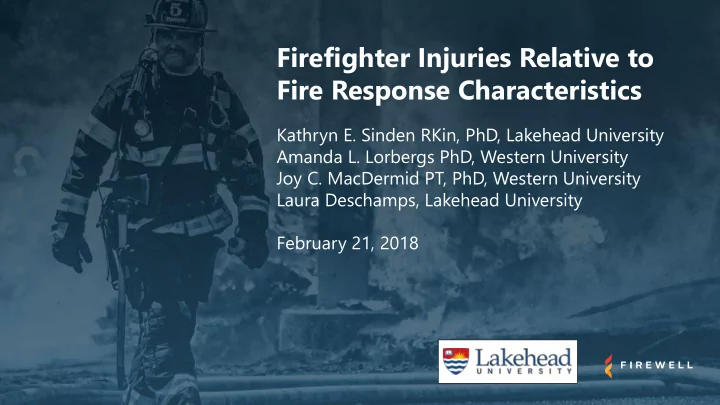

Firefighter Injuries Relative to Fire Response Characteristics Kathryn E. Sinden RKin, PhD, Lakehead University Amanda L. Lorbergs PhD, Western University Joy C. MacDermid PT, PhD, Western University Laura Deschamps, Lakehead University February 21, 2018
Our Research Question OVERARCHING OBJECTIVE: • To determine the relationship between specific fire response characteristics (e.g., firefighter personal attributes, personal protective equipment, action taken to manage fire) and firefighter injuries (e.g., cause, type) in Canada. Specific Research Questions: i. What are the firefighter injury characteristics including injury type, injury location, and length of absence from work associated with injury? ii. How do firefighter personal attributes (i.e., height, weight, years of service) relate to firefighter injury ? iii. Does firefighter personal protective equipment (i.e., helmet, gloves, coat, face shield) worn during emergency response impact firefighter injury cause and type ? iv. Do fire response characteristics (i.e., crew size, number of victims) impact firefighter injury ? v. Does geographical placement of the fire service impact firefighter injury cause and type?
What Did We Find? FIREFIGHTER SAMPLE FIREFIGHTER PERSONAL ATTRIBUTES AND INJURIES 2025 injured firefighters with 14.4 ± 8.6 years of service • 12% ( ≤30 years); 51% (31-45 years) and 37% ( ≥46 years) • Younger Firefighters (≤30 years) reported more • BMI = 27.3 ± 3.6 kg/m 2 (Overweight) • ‘wounds, punctures, lacerations’, ‘asphyxia, respiratory conditions’ and ‘minor cuts and bruises’ vs. middle aged (31-45 years) and older (46 years and older) FIREFIGHTER INJURY CHARACTERISTICS firefighters Most frequent reported injury type was ‘injury to muscle, • ligaments, joints’ (45%); injury location was the ‘head, neck or Younger firefighters reported fewer musculoskeletal • spine’ (11%). injuries vs. older firefighters (36% vs. 47%) Over 80% of injuries reported were categorized as “minor” • PPE AND FIREFIGHTER INJURIES (injuries requiring less than 1 day off work and / or in hospital) vs. “serious” (injuries requiring 16+ days off work Less severe injuries reported when helmets and boots • and / or hospitalization for 3+ days). worn Serious injuries reported when boots, helmet and coat • Longer absences from work appear to be associated with worn • ‘head, neck or spine’, ‘heart attack/stroke’, ‘bone injury or FIRE RESPONSE CHARACTERISTICS AND fracture’ FIREFIGHTER INJURY • Smaller initial and subsequent crew sizes may be related to more serious injury
Implications and Next Steps IMPLICATIONS NEXT STEPS Musculoskeletal disorders (MSDS) represent • • Injury prevention programs for firefighters an important injury burden among that target MSD prevention are warranted firefighters • Impacts on injury type and severity are Firefighting is an aging workforce required • Differences in injury type and severity may • • Contextualize new knowledge with our exist across age-groups existing firefighter research partners to verify Firefighter PPE may be an important • and incorporate with local data consideration in future injury prevention • Important as we continue with our research strategies initiatives in development, implementation Fire response characteristics (crew size and • and evaluation of current evidence-based fire alarm operation) may impact injury injury prevention programs. severity (length of absence from work) Firefighter injuries may increase as the total • number of injuries increases at the response scene
Acknowledgements This work was supported by the Canadian Safety and Security Program, a federal program led by Defense Research and Development Canada’s Centre for Security Science, in partnership with Public Safety Canada. Partners in the project include the Canadian Association of Fire Chiefs (CAFC), the Council of Canadian Fire Marshals and Fire Commissioners (CCFMFC), Public Safety Canada and Rhapsody Strategies Inc. The authors would also like to thank Dr. Vicki Kristman, Lakehead University for her comments and contributions to data analysis.
Recommend
More recommend